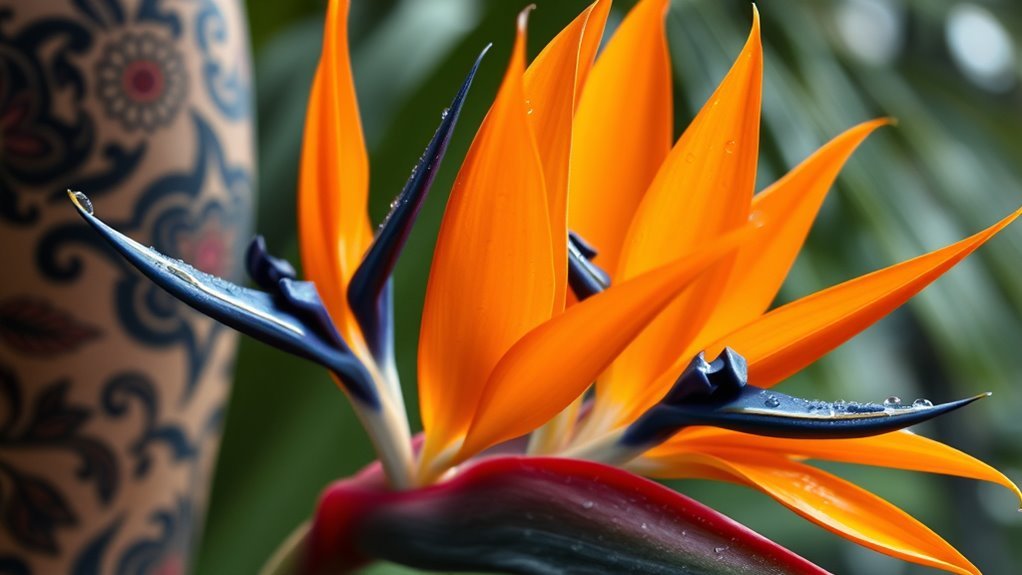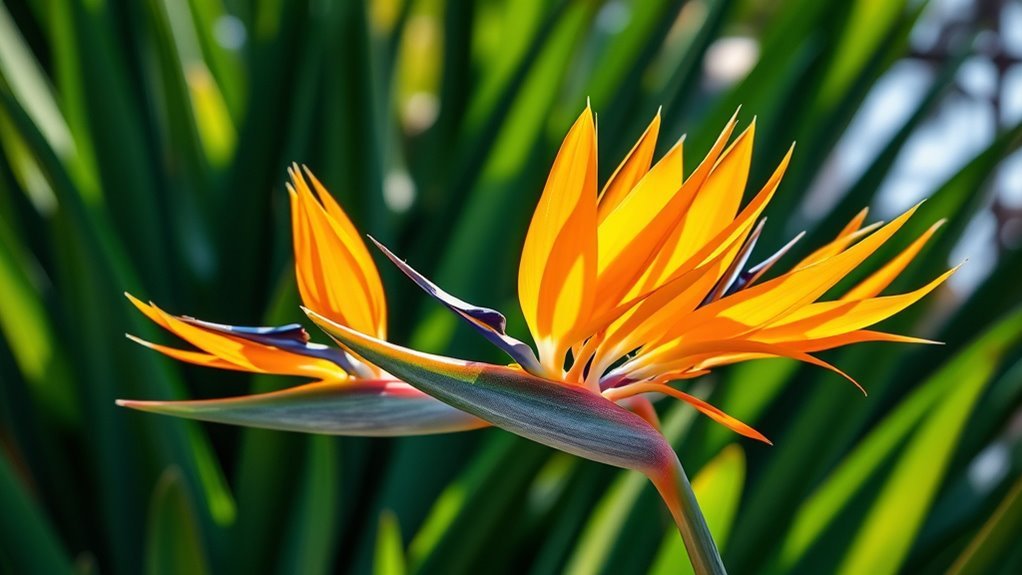Understanding the Meaning Behind Bird of Paradise Flowers
Bird of Paradise flowers are known for their striking appearance and meaningful symbolism. These vibrant blooms are not just for decoration; they represent important ideas in many cultures. Learning about their meanings can deepen your appreciation for their use in art, literature, and celebrations.
What messages do these flowers share about freedom, love, and transformation? Discovering these meanings can be enlightening and enjoyable. The Bird of Paradise embodies the essence of beauty and positivity in it's vibrant colors and unique shape.
Key Takeaways
- The Bird of Paradise flower symbolizes joy and paradise in various cultures, making it a popular decorative choice.
- In Hawaiian tradition, it represents freedom and is commonly used in leis during celebrations.
- African cultures view it as a sign of faithfulness and vibrancy, often included in ceremonial practices.
- Its unique appearance not only embodies beauty but also themes of transformation and hope in art and literature.
- The flower enhances modern decor while requiring specific care, including rich soil and regular maintenance for optimal growth.
The Origins of Bird of Paradise Flowers

Bird of Paradise flowers are beautiful. Their origins are in South Africa.
These flowers belong to the species called Strelitzia. Indigenous cultures used the leaves and fibers to create mats and baskets, showing their connection to nature.
Besides their beauty, these flowers have medicinal uses. They can reduce inflammation and are often made into teas for health benefits.
The Unique Appearance of Bird of Paradise
The Bird of Paradise flower has a captivating look. Its vibrant colors and unique shape resemble a bird in flight. You can see its long petals fanning out in bright orange and blue colors, creating a stunning visual effect.
The flower sits on a tall, straight stem, adding elegance to any arrangement. Its waxy surface reflects light beautifully, making the colors appear even more intense.
Each bloom comes from a sheath that looks like a bird's beak, emphasizing its avian resemblance. This distinct appearance makes the flower popular in tropical gardens.
It also piques curiosity and admiration in people, inviting them to appreciate the beauty of nature.
Cultural Significance in Various Societies

The Bird of Paradise flower holds a special meaning in many cultures. Its beautiful shape and bright colors symbolize joy and paradise.
In Hawaiian culture, the Bird of Paradise represents freedom and is often used in leis for important life events.
In many African cultures, it signifies faithfulness and vibrancy, appearing in ceremonies to symbolize prosperity and hope.
This flower connects people to their cultural heritage and builds a sense of community.
Understanding its significance worldwide increases appreciation for the Bird of Paradise.
Symbolism in Art and Literature
The Bird of Paradise flower is a vibrant symbol in art and literature. Its unique shape and bright colors attract artists and writers. This flower often represents beauty and exoticism.
In literature, it can symbolize freedom and human emotions. Writers use its striking appearance to express themes of transformation and hope.
Visual artists explore how this flower reflects nature and creativity. These representations invite you to think about your experiences and emotions through the beauty of this bloom.
The shared symbolism of the Bird of Paradise fosters a sense of connection among creators and audiences.
The Flower's Connection to Freedom

The Bird of Paradise flower symbolizes freedom through its unique shape and vibrant colors. Its bold petals resemble people reaching for the sky. The bright orange and blue shades shine in the sunlight, representing joy and liveliness.
This flower's exotic look invites thoughts of escape to beautiful places. The Bird of Paradise reminds us to embrace life's opportunities.
When you see this flower, let it inspire your journey to freedom and self-discovery. Enjoy its beauty and let it spark your adventurous spirit.
Representations of Joy and Happiness
The Bird of Paradise flower represents joy and happiness with its bright colors and distinctive shape.
Its vivid orange and blue petals create a sense of delight, making it a favorite for celebrations. This flower often appears in festive arrangements, weddings, and tropical-themed events.
When you give or display Bird of Paradise blooms, you share a message of positivity. Their bold shape reflects pure joy, resonating with those who seek connection.
In challenging times, these flowers remind us that happiness can be found in every moment.
Implications of Exoticism and Adventure
The Bird of Paradise is a flower that symbolizes joy and adventure. Its unique appearance and vibrant colors invite you to explore and experience life.
When you see this flower, you can imagine:
- Standing in lush jungles full of diverse plants.
- Discovering hidden beaches bathed in sunlight.
- Engaging with rich cultures, each with its own beauty.
This flower encourages exploration and connection. It represents the promise of new adventures and inspires you to expand your experiences and embrace the world around you.
The allure of the Bird of Paradise motivates you to seek out what's beyond the familiar.
Meanings in Floral Language
The Bird of Paradise flower symbolizes freedom and optimism. This vibrant flower represents birds in flight, inspiring thoughts of beauty and adventure.
Its striking shape and colors convey joy and a spirit of exploration. Giving someone a Bird of Paradise shows your hope for their growth and journey in life.
This flower encourages individuality while also promoting a sense of community where creativity thrives. By recognizing its meanings, you strengthen connections that uplift and inspire, celebrating the beauty of nature.
Bird of Paradise in Modern Decor
Incorporate Bird of Paradise flowers into your modern decor to create a vibrant atmosphere. Their bright colors and unique shapes can change any space.
Consider these ideas for using Bird of Paradise flowers:
- Place a tall vase with vivid orange and blue blooms in a visible spot to catch the eye.
- Use a striking arrangement as a centerpiece on your dining table to inspire conversation.
- Add fresh blooms to simple shelves to give them life and character.
These flowers enhance your modern aesthetic and bring a lively touch to your home.
Associations With Love and Romance
Bird of Paradise flowers add beauty to any decor and symbolize love and romance.
These vibrant blooms often appear in love stories, reflecting the allure of passionate relationships. Consider using them in your romantic gestures, such as a surprise bouquet or a centerpiece for a special dinner.
Their unique shape and colors can spark feelings of adventure and connection, enhancing the emotional atmosphere. Giving Bird of Paradise flowers expresses your sincere feelings, making your love feel more tangible.
Spiritual Interpretations of the Flower
Bird of Paradise flowers symbolize freedom and optimism. Their bright colors and unique shapes represent personal growth and creativity.
- The flower's shape resembles a bird, suggesting ambition and liberation.
- The vibrant colors reflect joy and positivity, promoting hope.
- Their distinct look encourages individuality and self-expression.
These flowers inspire you to reflect on your journey.
They help you feel connected to yourself and others. Bird of Paradise flowers motivate you to pursue your passions and find clarity in life.
They guide you to a more fulfilling existence.
The Role of Bird of Paradise in Gardens
Adding three or more Bird of Paradise plants can change your garden into a vibrant oasis.
These unique flowers bring a tropical look and brighten your garden with their bold colors and shapes. Place them next to other plants to create a balanced design that attracts attention and adds visual interest.
Bird of Paradise plants also attract pollinators like bees and hummingbirds. This activity enriches your garden's ecosystem and creates a lively atmosphere.
Caring for Bird of Paradise: A Symbol of Growth
Bird of Paradise plants are beautiful and symbolize growth.
To help your plant thrive, follow these care tips:
- Use rich, well-draining soil that holds moisture but drains excess water.
- Water your plant regularly, allowing the top inch of soil to dry out before watering again.
- Prune dead leaves to promote new growth and improve the plant's look.
Frequently Asked Questions
How Long Do Bird of Paradise Flowers Typically Bloom?
Bird of paradise flowers bloom for about one to three weeks. With proper care, you can see them bloom multiple times a year. Their colorful appearance adds joy to any garden. Enjoy their beauty while they are in season!
Are Bird of Paradise Flowers Poisonous to Pets?
Bird of Paradise flowers are not toxic to pets. You do not need to worry about harmful effects if your pet interacts with these plants. However, always observe your pet's behavior around new plants to ensure their safety.
What Climate Conditions Are Best for Growing Them?
To grow bird of paradise flowers successfully, provide warm temperatures and ample sunlight. Ensure the soil drains well to avoid root rot. These conditions will help create a thriving environment and lead to vibrant blooms and healthy plants.
Can Bird of Paradise Flowers Be Propagated From Cuttings?
You cannot propagate Bird of Paradise flowers from cuttings. Instead, use division or seeds for successful propagation. Focus on these methods to grow these beautiful plants effectively.
How Often Should Bird of Paradise Be Watered for Optimal Growth?
For optimal growth, keep the soil consistently moist. Water your bird of paradise every 1-2 weeks. Allow the top inch of soil to dry out between waterings. Change this schedule based on temperature and humidity.

Hello, I’m Emily Price, the founder of Birds Affection. As a passionate bird enthusiast and spiritual seeker, I’ve always been fascinated by the symbolic meanings and mystical connections between birds and our lives. On this website, I share my knowledge and insights on the spiritual significance of various bird species, exploring their roles as messengers, guides, and teachers. Through my writing, I aim to inspire and educate others on the profound wisdom and beauty that birds bring to our world. Join me on this journey as we delve into the enchanting realm of bird symbolism and discover the hidden meanings behind these magnificent creatures.







